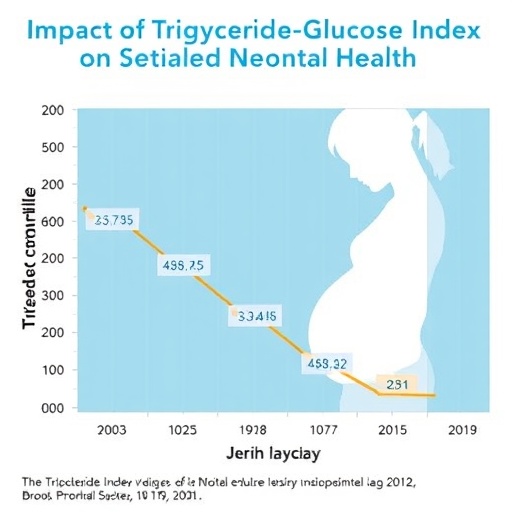In a significant advancement in maternal-fetal medicine, a recent observational study conducted by Duygulu Bulan and colleagues sheds light on the relationship between maternal and umbilical cord triglyceride–glucose index and neonatal health outcomes in the context of preeclampsia. This condition, characterized by high blood pressure and potential organ failure in expectant mothers, poses severe risks to both the mother and fetus. Thus, understanding predictive factors associated with neonatal health in preeclamptic pregnancies is crucial for developing effective management strategies.
Preeclampsia affects about 5-8% of pregnancies worldwide, leading to complications such as premature birth, low birth weight, and, in severe cases, stillbirth. The study conducted by Bulan et al. aims to explore how the triglyceride–glucose index—essentially a marker of insulin resistance and metabolic health—might influence neonatal outcomes. By focusing on both maternal and umbilical cord samples, this research allows for a more comprehensive understanding of metabolic conditions that could impact the fetus during crucial developmental periods.
The findings are based on a rigorous methodology that involved the collection of both maternal blood samples and umbilical cord blood at birth. The researchers measured triglyceride and glucose levels, calculating the triglyceride–glucose index for each participant. This index serves as an important marker of insulin sensitivity and is gaining traction as a predictor of adverse health outcomes. The ability of this index to forecast the health of neonates dramatically underscores its potential utility in clinical settings.
Further, the study outlines various neonatal health metrics, including Apgar scores, birth weights, and long-term health outcomes. By correlating these indicators with the triglyceride–glucose index, researchers were able to assess the direct implications of maternal metabolic health on newborns. The observational nature of this research highlights the necessity for further studies but also strengthens the argument that metabolic dysregulation during pregnancy can have lasting effects on children.
The results from this study are pivotal, offering clinicians and researchers new insights into managing pregnancies affected by preeclampsia. If the triglyceride–glucose index can reliably predict neonatal health outcomes, it could lead to heightened monitoring and tailored interventions. Early detection of at-risk pregnancies based on metabolic health could also contribute to preventing severe complications, ultimately improving both maternal and neonatal health.
As public health initiatives increasingly focus on the importance of nutrition and metabolic health during pregnancy, this study adds an essential layer to existing literature. The emphasis on monitoring triglyceride and glucose levels establishes a direct link between maternal diet, metabolic state, and neonatal well-being. This research not only echoes previously established findings but also expands on them by pinpointing specific biochemical markers that could enhance prenatal care.
Moreover, the implications of these findings extend beyond individual pregnancies; they suggest a potential framework for clinical practices regarding prenatal care for women facing preeclampsia and similar conditions. By integrating metabolic screenings into routine obstetric care, healthcare providers may be able to make proactive decisions about interventions that can improve outcomes for both mothers and their babies.
As this research gains attention, it shines a light on the multifaceted role that maternal health plays in the development of neonatal health profiles. Healthcare professionals must appreciate that addressing maternal obesity, diabetes, and metabolic syndromes could yield significant dividends not just for individual patients but also for public health as a whole. By prioritizing maternal health and metabolic monitoring, the healthcare system can work to reduce the incidence and severity of preeclampsia and its complications.
One must also acknowledge the importance of lifestyle modifications and interventions in this context. Dietary management, increased physical activity, and regular health screenings should become more integrated into prenatal care, especially for women at risk of developing preeclampsia. The evidence-based recommendations stemming from research like that of Bulan et al. can empower expectant mothers to make informed choices for their health and their baby’s future.
In summary, this groundbreaking study emphasizes the urgent need for continued research into metabolic health during pregnancy, particularly concerning preeclampsia. As our understanding of the links between maternal metabolism and neonatal health grows, so does the opportunity to transform prenatal care into a more proactive, health-centered model. Ultimately, this research could catalyze a new era of personalized medicine in obstetrics, where maternal conditions are carefully monitored and managed, enhancing the lifeline for vulnerable neonates.
The implications of the findings resonate deeply within the scientific community, leading to potential changes in clinical practice and further studies aimed at validating these preliminary results. As researchers strive to refine the use of the triglyceride–glucose index, the hope is to establish a clear guideline for its application in everyday clinical scenarios. This can potentially revolutionize how we view and treat metabolic conditions in pregnant women.
Moreover, the study has broader implications for understanding the interplay between obesity and pregnancy. With the rise of obesity rates globally, identifying accurate predictive markers becomes a public health imperative. By focusing interdisciplinary efforts on research like this, we can begin to tackle some of the most pressing issues in maternal and child health today, ensuring that all pregnancies are as healthy as possible.
In conclusion, the exploration of the maternal and umbilical cord triglyceride–glucose index opens new doors for preventing adverse neonatal outcomes in preeclampsia. It demonstrates how deepening our understanding of metabolic health can lead to meaningful changes in prenatal care and ultimately pave the way for healthier generations to come. Indeed, future research will be tasked with confirming these findings and expanding the knowledge base that will shape the future of maternal-fetal medicine.
Subject of Research: Maternal and umbilical cord triglyceride-glucose index and its predictive role on neonatal health in preeclamptic pregnancies.
Article Title: The predictive role of maternal and umbilical cord triglyceride–glucose index on neonatal health in preeclamptic pregnancies: a prospective observational study.
Article References:
Duygulu Bulan, D., Ayas Ozkan, M., Dayanan, R. et al. The predictive role of maternal and umbilical cord triglyceride–glucose index on neonatal health in preeclamptic pregnancies: a prospective observational study.
BMC Pediatr 25, 767 (2025). https://doi.org/10.1186/s12887-025-06185-4
Image Credits: AI Generated
DOI:
Keywords: Preeclampsia, neonatal health, triglyceride-glucose index, maternal health, metabolic health, insulin resistance.




